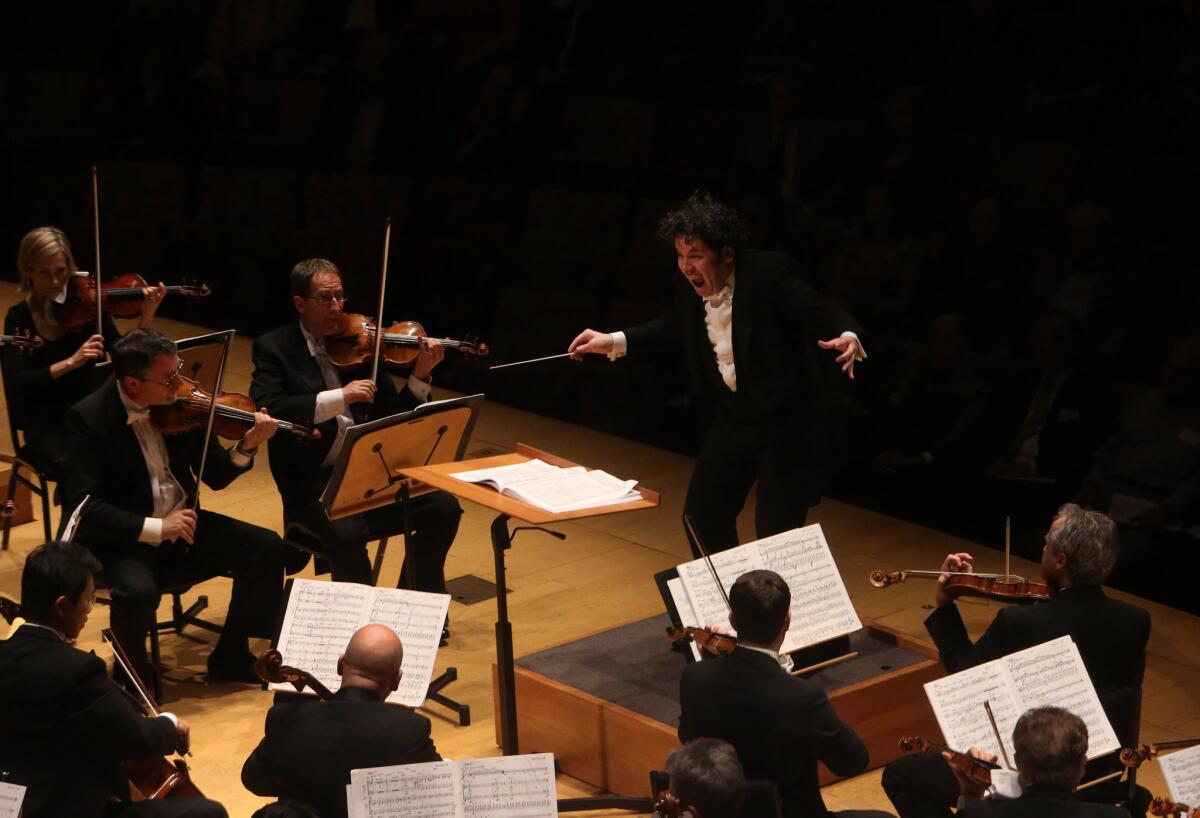Review: L.A. Phil brings immediacy to Corigliano’s Symphony No. 1

John Corigliano wrote his Symphony No. 1 in 1988 on a grand scale for an extravagant-sized orchestra. It is a multi-colored score containing a patchwork quilt of immense emotions.
The composer didn’t call it a war symphony, but that is what it is, an epic orchestral score for an epic tragedy, the AIDS epidemic. Audiences and orchestras, devastated by what the disease had wrought, understood. The symphony was needed, appreciated and widely played.
The urgency of those times is receding into memory, and Corigliano’s score is not so much heard any longer. There are two excellent recordings, and they are difficult to give away. Used copies on Amazon can be had for a penny.
CRITICS’ PICKS: What to watch, where to go, what to eat
Thursday morning’s news reported that a second infant born with HIV had been cured by a heavy barrage of drugs. Coincidentally, Thursday night’s news was that the Los Angeles Philharmonic brought back the urgency of Corigliano’s work in an astonishing performance conducted by Gustavo Dudamel at Walt Disney Concert Hall. The symphony, which now has the character of a vivid canvas of human struggle, never sounded stronger or more important.
In the preconcert Upbeat Live talk, the 76-year-old New York composer gave a vividly eloquent description of how he came to write the work and what exactly he meant to express. The Names Project AIDS Memorial Quilt inspired him. Its panels were a way to remember victims of the deadly virus, and Corigliano had three friends in mind.
The first movement is haunted by one friend’s love for a piano transcription of a Spanish tango by Isaac Albèniz, heard on an offstage piano. In the second movement, a mad tarantella tells of AIDS dementia. A chaconne, titled “Giulio’s Song,” utilizes an improvisation by a cellist friend of Corigliano’s. Two solo cellos momentarily sweep away a series of 12-tone chords in the rest of the orchestra for an instant of unforgettable intimacy, the kind only dying can bring. In the brief final movement, waves of brass lap over faint recollections of these themes, a symbol of the oceanic cleansing and renewal.
The specifics were what made the symphony matter most a quarter-century ago. Through it, many will relive the loss of friends and family. The orchestral world was hurt. An early AIDS death was the New York Philharmonic’s brilliant pianist Paul Jacobs. He was 53. Christopher Keene, the exceptional music director of New York City Opera, died of AIDS. He was 48.
FULL COVERAGE: Walt Disney Concert Hall at 10
But for the symphony to last, it must also stand on its own and attain new relevance. Like a symphonic AIDS treatment, it is a heavy dose of an alternately aggressive and soothing sonic cocktail. And Dudamel, in brilliant form, administered immediacy to every instance.
The emotions are ones everyone is familiar with in times of crisis. The symphony rages in climaxes so loud that it drove one couple in the front row away. Wind and string players sitting in front of the titanic brass and percussion sections could be seen regularly inserting and removing earplugs.
But those horrifying outbursts only made the many more moments of tenderness and a kind of wonderful craziness, of grotesqueries and the beautifully warm and even fuzzy sentiments all the more meaningful. The L.A. Phil — with heart-stopping solos from cellists Robert deMaine and Ben Hong and pianist Joanne Pearce Martin — was the Technicolor applied to the large symphonic screen. In shorting lives, AIDS sped up life, and so does Corigliano in 42 minutes.
Brahms’ most lyrical symphony, his second, followed after intermission. That seemed an inevitable anti-climax after the revelatory intensity and immediacy Dudamel brought to Corigliano’s modern invention. The Second Symphony, moreover, was the least polished of Dudamel’s Brahms Unbound festival two years ago. His interpretation was slow, pleasingly lyrical and, at the end, comfortably exuberant.
This time the symphony offered considerably more. It begins as a lullaby, and Dudamel treated that as if it were a meditation on birth and ripening maturity. He thickened mellow inner voices. He looked for ways to find expression in details yet maintained a large illuminating line.
GRAPHIC: Highest-earning conductors
Corigliano’s symphony is a study in what, in our minds, connects and what doesn’t, as we begin to lose them. Dudamel used Brahms to put everything together. This time the last movement wasn’t just exuberant or unbounded Brahms, it was unbuttoned. He used Brahms to put everything right. The L.A. Phil strings were lushly impressive as they had once been in Brahms under Carlo Maria Giulini. Andrew Bain’s idyllic horn solos hung in the air as though they were meant to stay there.
Next week, the L.A. Phil takes these two symphonies on a U.S. and Canada tour (along with Tchaikovsky’s Fifth Symphony, Rachmaninoff’s Third Piano Concerto with soloist Yuja Wang and Daníel Bjarnason’s “Blow bright”). It is ready.
------------------------------------------------------
Los Angeles Philharmonic
Where: Walt Disney Concert Hall, downtown L.A
When: 8 p.m. Sat; 2 p.m. Sun
Cost: $23.75- $205
Info: (323) 850-2000 or https://www.laphil.org
More to Read
The biggest entertainment stories
Get our big stories about Hollywood, film, television, music, arts, culture and more right in your inbox as soon as they publish.
You may occasionally receive promotional content from the Los Angeles Times.











